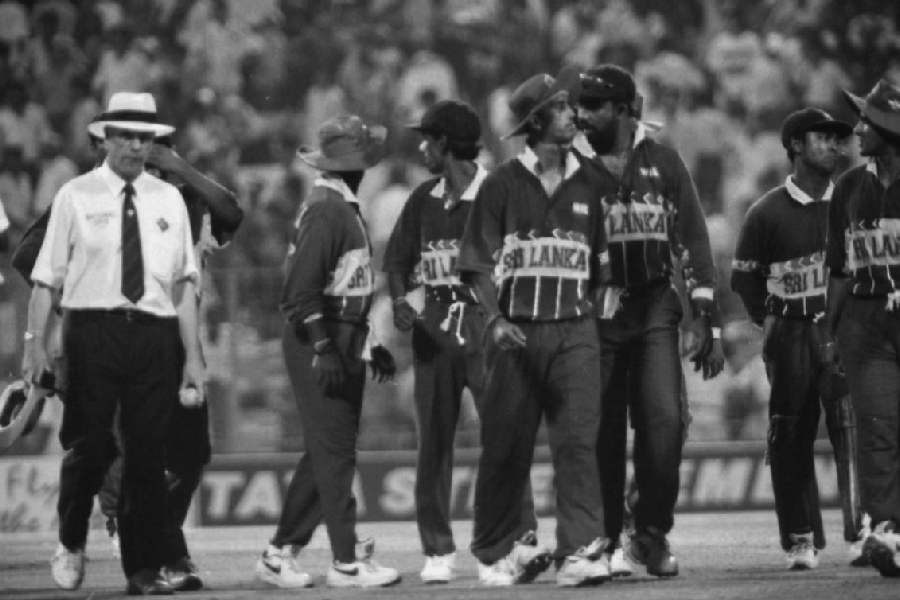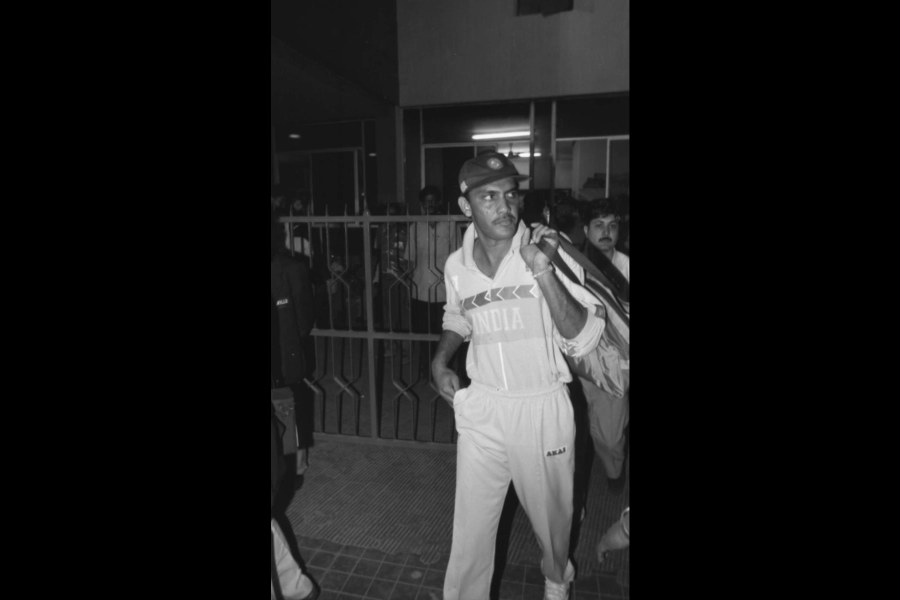The eve of the Ides of March, 1996. The headline in this newspaper read: "Calcutta shows its ugly face as India crashes to defeat."
It was the morning after the fabled cricket-loving crowds at the Eden Gardens had disgraced themselves, the city and the country by resorting to rampage as India slipped inexorably in the World Cup semi-final against Sri Lanka.
That happens to be the only ODI World Cup game India have ever played at the storied Eden. (In 2011, the India v England game was moved out because the ICC didn’t rate the stadium match-ready.) Since then much water has flown down the Hooghly but the scars of that evening have never quite healed.
Twenty-seven years is, of course, a long time. A generation that was not even born then has taken over the mantle of cricket's fandom. Cricket itself has changed, with ODIs looking for reinvention because the format finds itself squeezed between the flourishing legacy of Test matches and the excitement of T20s. Also, the IPL has made cricket razzmatazz an annual affair.

Sri Lanka players leaving the field after a barrage of soft drink bottles were hurled from the stands. Telegraph picture
Back then, however, the ODI World Cup was the big stage of cricket, the first mega-event co-hosted by the nation post-liberalisation. India had a strong team and had just vanquished Pakistan in a charged quarter-final in Bangalore. The mood was one of euphoria, it was war minus the shooting.
It is said that the newsroom of one newspaper had in their excitement decided on the next day’s headline even before the toss: “Onward to Lahore”, the dummy Page 1 headline screamed in bold capitals, confident that India would play itself into the final.
Fans and the media, then and now, exist in a penumbra of make-believe: India are world-beaters, nobody can touch us in either ability or performance; be it the Tendulkars or Kohlis or Bumrahs, we are the greatest, anything less is unacceptable.
Players are deified, the advertisement industry has played along all the while, the IPL has ensured it has become habit-forming to assume that the larger-than-life images are the real thing.
Nothing wrong with it if fans can take results not to their liking in their stride. But that March evening, when confronted with reality, they couldn’t take it.
The reason was simple: their imagined gods had reduced themselves to fallible, commonplace mortals.
Eden had certainly not expected this. Captain Azharuddin’s decision to field first had seemed justified when Sri Lanka went two down with just one run on the board. Then walked in Aravinda de Silva to take control; the visitors posted 251 for 8 in 50 overs.
India began their reply with Sachin Tendulkar batting like only he can, putting on 90 with Sanjay Manjrekar for the second wicket. The first shock rippled when Tendulkar was dismissed for 65 with India at 98/2. Soon it was 99/3 with Azhar dismissed for a duck. The skipper was booed all the way back to the dressing room, a portent of things to come.
The first of the soft drink bottles went twirling into the field of play the moment Ajay Jadeja was bowled, plunging India to 115 for 6. Then, after Aashish Kapoor was caught at mid-wicket in the 35th over with the score at 120 for 8, all the blocks adjacent to the sight-screens on either side of the ground went into action with a killer instinct that the Indian team had lacked through the day.
A barrage of plastic soft drink bottles flew in. Sri Lankan fielders on the deep midwicket fence in front of Block G and the sweeper cover position on the other side of the ground took the brunt of the assault.
As Sri Lanka captain Arjuna Ranatunga put his foot down and refused to continue to play, the frenzied crowd began to bay for more blood. Crackers began going off around the stadium. The chants had become bloodthirsty by now, proclaiming “Azharuddin hai hai” and “India hai hai”.
Some who didn’t wish to see the city disgraced in such fashion were in too small a minority.
“Clear out if you don’t like this. This is what they deserve. They cheated us,” screamed another spectator as he got ready with another missile in the Block H stands.
Umpires Cyril Mitchley and Steve Dunne, and ICC match referee Clive Lloyd, a former West Indies captain much loved by earlier Eden crowds, decided to come off for a while to persuade the Sri Lankans to resume play on the condition that no further missiles would be thrown.
Play resumed but, promptly, almost as if it were a flaming welcome, a glass bottle was hurled from Block G at Kumar Dharmasena who was fielding on the boundary. The match was called off with 15 overs still to be bowled. Lloyd awarded the game to Ranatunga’s team — the official result says Sri Lanka won by default. The image that lingers to this day is of Vinod Kambli, one of the batters still at the crease, hanging his head and weeping amid all the chaos.
The savage crowd had turned against its own, expressing its anger at what the late scholar Ashok Mitra described as their “ersatz heroes”.
Violence is not new to the Eden. During the New Year’s Test of 1966-67 against the West Indies, irate spectators had gone on the rampage inside the stadium, upset over the extra tickets sold that led to congestion in the stands.
Police had resorted to lathi-charge and tear-gassing to control the frenzy. The West Indian players had to take refuge in the team hotel and it is to their credit that they agreed to continue playing.
On August 16, 1980, 16 fans died in a stampede triggered by anger at the referee’s decision during a Calcutta football derby between Mohun Bagan and East Bengal.
And in 1999, a Test match between India and Pakistan was played before empty stands after a section of spectators resorted to pelting Pakistani players with bottles after Sachin Tendulkar was given run out.
But the scars of that semi-final of cricket’s biggest tournament have remained. While Chepauk in Chennai remains a ground known to appreciate good cricket irrespective of who’s playing it, the Eden has lost that aura.
The cricket experience at the Eden, too, has turned into a poor shadow of how things used to be. Food has been disallowed, those fine sandwiches and luchi-torkari savoured under the crisp winter sun are a thing of the past, water has now to be sipped from plastic pouches: no bottles, please.
India, already in the semi-finals of this World Cup and looking every bit a
champion team with seven wins on the trot, will face South Africa at the Eden on Sunday. It’s not a must-win game, the stakes are not as high as they were on that March evening in 1996.
But even if it were, one can only hope that the Eden fan has matured and can appreciate good cricket.
Cricket lovers from an earlier, pre-liberalisation era, with their daily struggles and tribulations, knew you cannot win all of life’s battles. One hopes the Eden
of a much-changed new India, with its 56-inch nationalistic pride, has learnt to
embrace grace.











